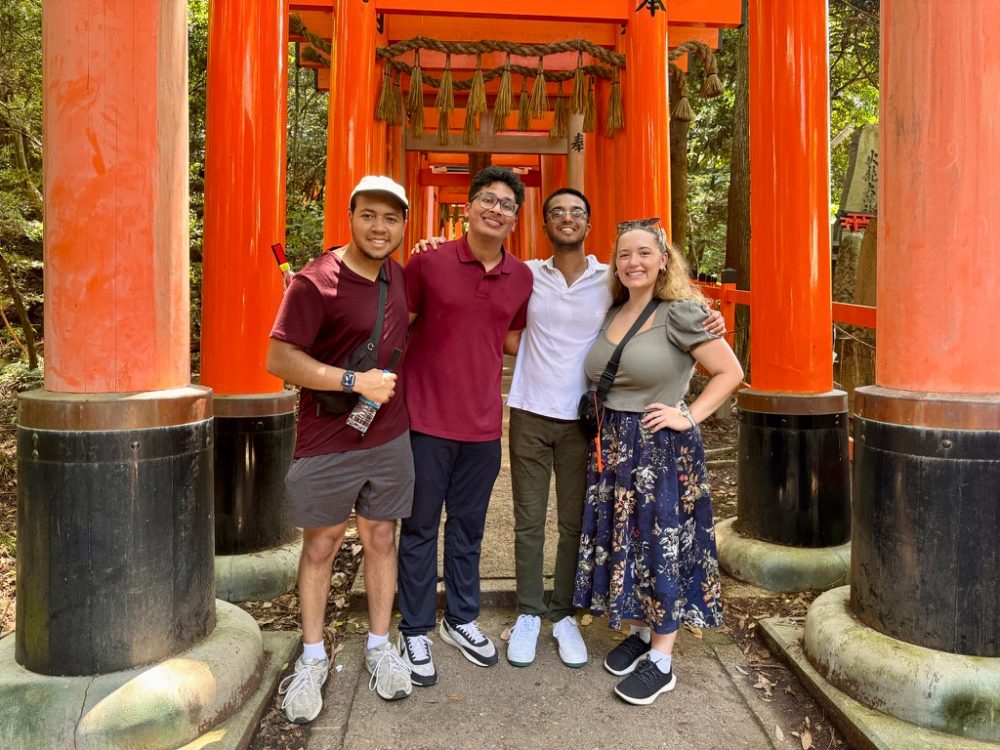Life-Changing but Not Life-Defining: Disaster Recovery in Japan – Abby Cameron ’26

The first weekend of my study abroad experience in Japan left me stunned by the natural beauty of the winding mountainous roads of the coastal Tohoku region. For most people, traveling in Japan generates an image of the bustling Shibuya Crossing in the heart of Tokyo. For sixteen other UNC Charlotte students and I, exploring the stunning rural community of Ishinomaki, Japan would become a treasured memory and highlight of our experience abroad. Over the next four weeks our group studied natural disasters in Japan and the economic, cultural and environmental factors that can impact a community’s vulnerability to them. That weekend was my first introduction to the lasting impact of The Great East Japan Earthquake and Tsunami that had occurred more than a decade earlier.
On March 11, 2011, a 9.0 magnitude earthquake struck off the coast of the Tohoku Region and resulted in a tsunami that took the lives of over 20,000 people. Prior to arriving in Japan we all read Ghosts of the Tsunami, a narrative nonfiction book on the impact of the 3/11 tsunami on a rural community near Ishinomaki and the loss of 74 school children in a failed evacuation effort ahead of the wave. When the charter bus stopped in Ishinomaki I was shocked. There was nothing there except the river, a bridge and some overgrown grass on the rolling hills. The place that I had read about in Ghosts of the Tsunami was a small but lively town. Turning around I saw all that remained of this community: the ruins of Okawa Elementary School. Standing alone in an expanse of nothing, the school looked out of place and it was hard to picture that just thirteen years ago this barren riverbank was a place hundreds of people called home.
The details stick with me: the clock hands forever resting at 3:37pm and the fading mural near where the gym used to stand. Above it all stood the hill behind the school with the small but painful marker of the place where the water stopped rising. The flat ledge just above that where those children would have been safe if a different evacuation decision had been made that day. Until that fateful Friday, over a hundred elementary school children walked into their classrooms with their bright smiles and buzzing energy. Though the ruin acts as a painful reminder of the consequences of inadequate disaster preparation, it also functions as a memorial to the lives of those lost and grief of the community that will always feel incomplete without them.
Over the next few weeks we engaged in lectures, discussions and workshops on disaster risk reduction. I gained invaluable knowledge on all the social and geographical factors that can impact a community’s vulnerability or resilience to natural hazards. On the final weekend of our trip we returned to the coast to stay with locals in Minamisanriku. These host-moms spoke little more English than we spoke Japanese. Madison Lewis ’26 and I were placed together in the home of Ryoko San for one night. She dressed us in Yukata and allowed us to pick out what we wanted for dinner from the supermarket. That night we sat around the table with multiple varieties of fish and seaweed and drank matcha while we talked. She told us about her family and her love of tai chi and the tsunami. She shared her home, stories and time with us generously that night and when it was time to return to Sendai the next morning, Madison and I left a piece of our heart with her in that little home with the hydrangea bush.
These two real world experiences in the Japanese countryside bracketed a month of study on the 2011 Great East Japan Earthquake and Tsunami and the lasting impact it has on the Tohoku Region today. The most important message I took away was that while the tsunami changed a lot, this tragedy does not define the lives of its victims or the survivors. Ryoko San told us, “Once the temporary housing was built—I finally felt like I could move on. It was hard for a while but now I am as happy and healthy as ever.” The parents of the children lost at Okawa Elementary School spoke of their children’s aspirations and achievements, along with the joy they added to their families lives. The most inspiring part was not just how they rebuilt their businesses, but how these communities did not allow this loss to define them. For Ryoko San, there was a before 3/11, but there is also after. All the joy and laughter of life was not stolen by the tidal wave. Healing is found in patience, generosity and community.
